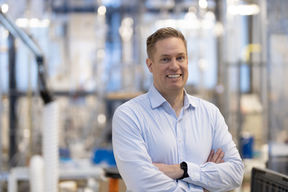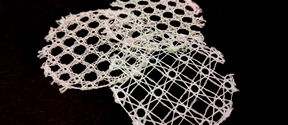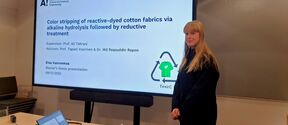Jukka Niskanen brings polymer engineering expertise to Aalto University

Jukka Niskanen started his five-year assistant professorship at the School of Chemical Engineering in January 2023. Niskanen's research area is polymer engineering.
'I study the synthesis and preparation of polymers, starting from the starting materials, how polymers behave, what properties they have, and invent their potential applications. I also intend to use plastic and polymer waste to make new polymers and materials,' says Niskanen.
Although polymer science is often thought of as the study of oil-based plastics, Niskanen also studies bio-based materials such as cellulose and polyesters and their properties.
'In this unit, where I start my work, we have a strong tradition in polyolefins and polymer technology, but also in biopolymers. Professor Jukka Seppälä is in a class of his own in this field. Of course, I want to honour the traditions he has created and continue them in some form.'
Background as a postdoc and technical expert in industry
Niskanen worked in Canada for eight years. The majority of this time was spent as a postdoctoral researcher at the University of Montreal and, with funding from the Academy of Finland, as a postdoctoral researcher in collaboration between Montreal and Helsinki. Niskanen also spent six months as a visiting researcher in Tsukuba, Japan, less than an hour from Tokyo.
In addition to Montreal, Niskanen has also worked at a rubber extrusion plant in Ontario and at the University of Ottawa studying photoactive materials for OLED displays.
'The company made rubber profiles for railways and ports and I was solving problems related to their extrusion. It was very instructive to see how a theoretical issue turned into practice. In Ottawa, on the other hand, I really got to explore organic chemistry. The substances were prepared according to the partner's structures and wishes, at a pretty fast pace, on average two grams per week,' says Niskanen.
Before coming to Aalto, Niskanen worked at VTT for more than a year, researching durable materials and polymers.
Industrial scale and multidisciplinary cooperation
Niskanen is excited about the possibilities of his new working environment. He looks forward to applying his expertise closer to the industrial scale, which will emphasise not only basic research but also the commercial feasibility of the work.
'My idea is that at Aalto University, I will be able to influence the whole life cycle of polymers, from synthesis to the creation of practical materials and their recycling or reuse. Here at Aalto, we have the equipment, the tools and the know-how in a rather unique capacity.'
Niskanen also hopes to combine his own polymer expertise with Aalto's materials science research, for example.
'Polymers can be used to make smart fibres, so textile design would be a natural direction. Another interesting direction is electronics - I have done some work on semiconducting materials in the past. I would need to find a good partner for that.'
In addition to his research, Niskanen likes to spend time with endurance sports like running and swimming. He also spends some of his free time playing video games.
'I've heard somewhere that when you move your body, you think more efficiently. So a long jog gives me plenty of time to think about things.'
Read more news

Smart textiles are reshaping our understanding of materials – and interspecies communication
The PAST-A-BOT research project, funded by the European Research Council (ERC), is developing soft, intelligent textiles that could one day function as rescue robots, sound-sensing agricultural fabrics, or assistive clothing. At the same time, the project aims to rethink the way we approach materials research.
Master’s student showcases efficient color stripping of cotton fabrics
On December 9, master’s thesis student Elsa Vuorenmaa from the Textile Chemistry Group presented the results of her research on color stripping of reactive-dyed cotton fabrics.
Future makers research batteries, cryptography and plastic recycling
The Technology Industries of Finland Centennial Foundation awarded 3.5 million euros in research funding to eight projects, five from Aalto University.






